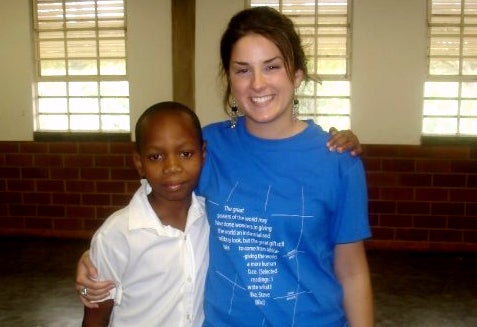Dispatches:
Lucienne Cross
Kimberly Cummins
Carla Anderson
▸ Lillianna O’Brien-Kovari
Andrea Hudson
Mansi Goyal
Kelsey Kennedy
Rodney Brown
Erika Purcell-Williams
Rahsaan Grissom
Rocky Block
Creating a Space to Foster Empowerment
This week we traveled to Durban, a large city on the eastern coast of the country, slightly south of Johannesburg. Our itinerary for the stay in Durban involved teaching at Cato Crest Primary School, located in a township a few minutes from Durban. On Friday, we met with the faculty that would help us with the children since Monday through Wednesday we were to teach thirty students from the seventh grade, the senior grade at Cato Crest Primary School.
I have never felt so well received as I was at Cato Crest. A large part of that feeling had to do with an absence of young kids in my life. But an even greater part had to do with the faculty. Though said many times on this trip, the fact that those with little to share often give the most bears constant repeating. There were so genuinely hospitable under truly difficult circumstances and epitomized the commitment to the new South Africa. Cato Crest houses 976 students, usually with 65 pupils to a teacher. Cato Crest is also home to many HIV orphans, 20 of whom recently lost their parents in the last year. The township covered in tin houses and packed together in a tight communal space – a stark contrast to the plush architect of Durban, literally next door. However, this segregation of class and wealth does not take away from the radical transition across South Africa, seen in even the smallest details – like the names of signs changing from Campbell to Steve Biko road, Essenwood road to Stephen Dlamini, or Brewer Road to King Dinizulu.
On the first day of teaching, per usual, I was quite nervous. But this particular nervousness stemmed from having to rethink the way in which we teach the module. So far, we have only taught students of our own age; thus, the references we used were representative of those similarities. Twelve year olds, on the other hand, are a bit trickier. Some students have little to know knowledge of sex and HIV, whereas others are considered rather experienced. And because there is no universal sexual education program, even the most experienced students have deeply misconceptions of HIV and sex.
To further complicate the program, HIV education is very confusing because of all the contradicting information provided by many “well intended” organizations. However, my partner, Carla, and I devised an interactive and simple way to explain sexual friction, mother-to-child transmission, how condoms work and how to “interact with” HIV positive people. Though the amount of understanding that our students had about HIV was very clear, the most important part of teaching the module is not the information, but that our students felt capable of taking this information and telling other people with confidence and deliberation. HIV education is just the avenue through which they found empowerment.
The most fulfilling part of our work was when one of my shyest students, Chamaine, wrote a poem about HIV. At first, she did not want to read it in front of the entire school because she was worried everyone would make fun of her. But part of the program is to create a space to foster confidence and empowerment. A similar experience happened with our other student Sfiso, who refused to speak for three days. Later we discovered that his mother died, he could not read or write and he was having a lot of trouble at home. However, because of the program, he began to play and engage with everyone, including Carla and Me.
Cato Crest was the most fulfilling part of this trip for me, not just because of the great time that I had with Sfiso, Lungelo, Sandile, Chamaine, Slindile, Awelile, Ntombizonke, Nokuphiwa, Nomzamo and Anthienkosi but because it really gave me hope in change and hope in humanity.
Lillianna O’Brien-Kovari – Teammate Pedagogy of Action 2009


